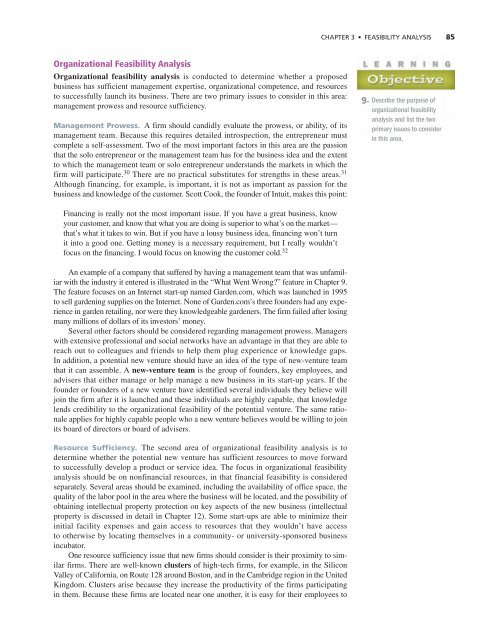feasibility analysis feasibility analysis
feasibility analysis feasibility analysis
feasibility analysis feasibility analysis
You also want an ePaper? Increase the reach of your titles
YUMPU automatically turns print PDFs into web optimized ePapers that Google loves.
CHAPTER 3 • FEASIBILITY ANALYSIS 85<br />
Organizational Feasibility Analysis<br />
Organizational <strong>feasibility</strong> <strong>analysis</strong> is conducted to determine whether a proposed<br />
business has sufficient management expertise, organizational competence, and resources<br />
to successfully launch its business. There are two primary issues to consider in this area:<br />
management prowess and resource sufficiency.<br />
Management Prowess. A firm should candidly evaluate the prowess, or ability, of its<br />
management team. Because this requires detailed introspection, the entrepreneur must<br />
complete a self-assessment. Two of the most important factors in this area are the passion<br />
that the solo entrepreneur or the management team has for the business idea and the extent<br />
to which the management team or solo entrepreneur understands the markets in which the<br />
firm will participate. 30 There are no practical substitutes for strengths in these areas. 31<br />
Although financing, for example, is important, it is not as important as passion for the<br />
business and knowledge of the customer. Scott Cook, the founder of Intuit, makes this point:<br />
9. Describe the purpose of<br />
organizational <strong>feasibility</strong><br />
<strong>analysis</strong> and list the two<br />
primary issues to consider<br />
in this area.<br />
Financing is really not the most important issue. If you have a great business, know<br />
your customer, and know that what you are doing is superior to what’s on the market—<br />
that’s what it takes to win. But if you have a lousy business idea, financing won’t turn<br />
it into a good one. Getting money is a necessary requirement, but I really wouldn’t<br />
focus on the financing. I would focus on knowing the customer cold. 32<br />
An example of a company that suffered by having a management team that was unfamiliar<br />
with the industry it entered is illustrated in the “What Went Wrong?” feature in Chapter 9.<br />
The feature focuses on an Internet start-up named Garden.com, which was launched in 1995<br />
to sell gardening supplies on the Internet. None of Garden.com’s three founders had any experience<br />
in garden retailing, nor were they knowledgeable gardeners. The firm failed after losing<br />
many millions of dollars of its investors’ money.<br />
Several other factors should be considered regarding management prowess. Managers<br />
with extensive professional and social networks have an advantage in that they are able to<br />
reach out to colleagues and friends to help them plug experience or knowledge gaps.<br />
In addition, a potential new venture should have an idea of the type of new-venture team<br />
that it can assemble. A new-venture team is the group of founders, key employees, and<br />
advisers that either manage or help manage a new business in its start-up years. If the<br />
founder or founders of a new venture have identified several individuals they believe will<br />
join the firm after it is launched and these individuals are highly capable, that knowledge<br />
lends credibility to the organizational <strong>feasibility</strong> of the potential venture. The same rationale<br />
applies for highly capable people who a new venture believes would be willing to join<br />
its board of directors or board of advisers.<br />
Resource Sufficiency. The second area of organizational <strong>feasibility</strong> <strong>analysis</strong> is to<br />
determine whether the potential new venture has sufficient resources to move forward<br />
to successfully develop a product or service idea. The focus in organizational <strong>feasibility</strong><br />
<strong>analysis</strong> should be on nonfinancial resources, in that financial <strong>feasibility</strong> is considered<br />
separately. Several areas should be examined, including the availability of office space, the<br />
quality of the labor pool in the area where the business will be located, and the possibility of<br />
obtaining intellectual property protection on key aspects of the new business (intellectual<br />
property is discussed in detail in Chapter 12). Some start-ups are able to minimize their<br />
initial facility expenses and gain access to resources that they wouldn’t have access<br />
to otherwise by locating themselves in a community- or university-sponsored business<br />
incubator.<br />
One resource sufficiency issue that new firms should consider is their proximity to similar<br />
firms. There are well-known clusters of high-tech firms, for example, in the Silicon<br />
Valley of California, on Route 128 around Boston, and in the Cambridge region in the United<br />
Kingdom. Clusters arise because they increase the productivity of the firms participating<br />
in them. Because these firms are located near one another, it is easy for their employees to

















